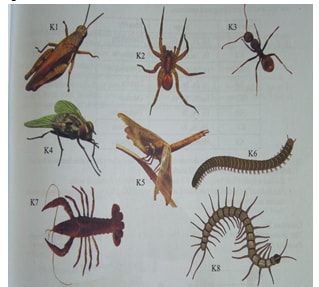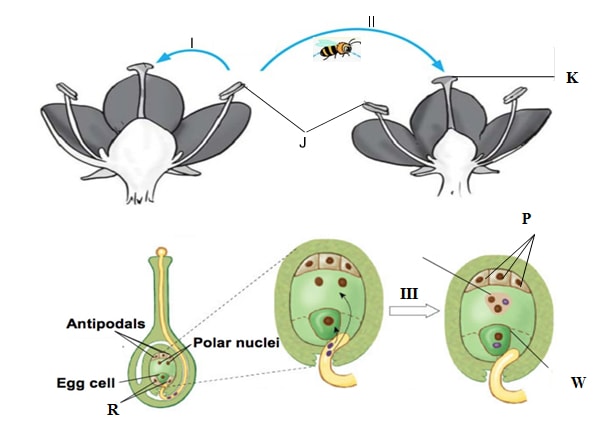- You are provided with liquid X and substance Q
- Place three drops of liquid X onto a white tile. Add four drops of iodine solution and record your observation. (lmk)
- Pour 2ml of liquid X into a test-tube. Add equal amounts of Benedict’s solution boil the mixture. Record your observation (lmk)
- Label three boiling tubes as set-ups A, B, and C. Place 3m1of liquid X into each of the set-ups. Divide substance Q into three equal portions.
To set-up A, add one portion of substance Q and shake.- Place the second portion of substance Q into a test tube. Add 1ml of water to it and boil for four minutes. Add it to set-up B and shake.
- To set —up C, add the third portion of substance Q. Add 8 drops of 2M hydrochloric acid and shake.
- Place the three set-ups in a warm water bath maintained at 37°C for 30minutes.
- Cool the set-ups by dipping the boiling tubes in cold water
- Place 2ml of the contents of each set-up into three separate test tubes. Add equal amount of Benedict’s solution to each of the three test-tubes and boil.
- Record your observations (3mks)
Set-up A
Set-up B
Set-up C - Account for your observations in the set-up (3mks)
Set-up A
Set-up B
Set-up C - Give the most likely identity of substance Q (1mk)
- Why was the water bath maintained at 37°C (lmk)
- What is the fate of the product of set up A in an organism? (2mks)
- Below are photographs of a variety of invertebrates. Examine them and answer the questions that follow.

- Complete the dichotomous key given below. (5mks)
-
- Animal with three pairs of legs…………………………………………….………..go to 2
- _______________________...................................................go to 5
-
- Animal with wings…………………………………………………………..……….go to 3
- Animal without wings………………………………………………………...Hymenoptera
-
- Animal with one pair of wings……………………………………………………….Diptera
- ___________________ ......................................................go to 4
-
- Fore wings hard……………………………….…………………………………..Orthoptera
- Fore wings membranous…………………………………………………………….Odonata
-
- __________________________....................................................go to 6
- Animal with more than four pairs of walking legs……………………………………go to 7
-
- _____________________..................................................Crustacea
- Animal without antennae……………………………………………………….…..Arachnida
-
- ______________________________________………….……………………..Chilopoda
- Animal with two pairs of legs in each body segment …………………………..Diplopoda
-
- Use the dichotomous key to identify the specimen in the photographs above. (8mks)
Specimen
Steps followed
Identity
K1
K2
K3
K4
K5
K6
K7
K8
- Complete the dichotomous key given below. (5mks)
- All members of plant division Spermatophyta exhibit alternation of generation. The photographs below show stages in the growth and development of a spermatophyte.

- Processes I, II and III. (3mks)
I
II
III - Structures K, P, R and W. (4mks)
K
P
R
W - The cell division process that occurs in structures J. (1mk)
- The products of the process named in (iii) above. (1mk)
- Explain the role of the following in promoting process II in the flowering plants.
Petals (2mks) - The photographs above represents one of the phases in alternation of generations in spermatophytes. Name the phase. (1mk)
- Explain the role of the following in promoting process II in the flowering plants.
- Processes I, II and III. (3mks)

MARKING SCHEME
-
- Blue black/black dark blue colour is formed
- No colour change/colour of Benedict’s solution remains;
Rej: No change /no reaction/ no observation /nothing happens - Set-up A- colour changes from blue to green to yellow to orange/brown;
Set-up B: No colour change/ colour of Benedicts’ solution remains;
Rej- No change/no reaction/no observation/nothing happens
Set-up C- No colour change/colour of Benedict’s solution remains;
Rej- No change no reaction/ no observation/ nothing happens - Set-up A — Enzyme amylase/diastase/invertase (in Q); digests /hydrolysis/breaks down/converts starch (in liquid X); to reducing sugar/maltose;
Set-up B: boiling denatures/destroys enzymes amylase/diastase/invertase; hence starch is not converted to reducing sugar/maltose;
Set up C:- Hydrochloric acid provides unfavorable pH for enzyme amylase diastase/invertase; hence starch is not converted to reducing sugar/maltose; - Enzyme amylase/diastase/invertase;
- To provide optimum temperature for enzymatic reaction
- Broken down to glucose. Glucose is oxidesed to provide energy during cellular respiration In excess it is converted to glycogen in animals or starch for storage in plants.
-
- Animal with more than three pairs of legs ……….....................................................go to 5
Animal with two pairs of wings ………………….......................................................go to 4
Animal with four pairs of walking legs …………........................................................go to 6
Animal with antennae ……………….……………...................................................Crustacea
Animal with one pair of legs in each body segment………….……………………..Chilopoda
1 x 5 = 5mks -
Specimen
Steps followed
Identity
K1
1a, 2a, 3b, 4a
Orthoptera
K2
1b, 5a, 6b
Arachnida
K3
1a, 2b
Hymenoptera
K4
1a, 2a,3a
Diptera
K5
1a, 2a, 2b, 4b
Odonatan
K6
1b, 5b, 7b
Diplopoda
K7
1b, 5a, 6a
Crustacea
K8
1b, 5b, 7b
Chilopoda
1 x 8 = 8mks; Award a mark for identity only when the steps followed are correct.
- Animal with more than three pairs of legs ……….....................................................go to 5
-
- I – Self pollination
II – Cross pollination
III – Double fertilization - K – Stigma
P – Antipodal cells
R – Synergids. Rej: Synergid
W – Diploid zygote. Rej: Zygote, Embryo. - Meiosis
Pollen grains - Petals – Brightly colored; to attract insects; (for cross pollination)
Filaments – Long; to expose the anthers to the agents of cross pollination. - Gametophyte
- I – Self pollination
Download BIOLOGY PAPER 3 - 2019 KCSE KASSU JOINT MOCK EXAMS (QUESTIONS AND ANSWERS).
Tap Here to Download for 50/-
Get on WhatsApp for 50/-
Why download?
- ✔ To read offline at any time.
- ✔ To Print at your convenience
- ✔ Share Easily with Friends / Students

